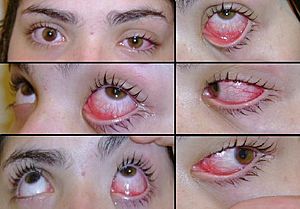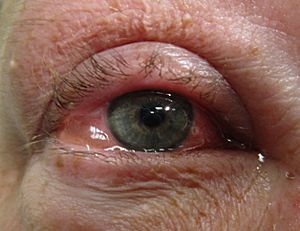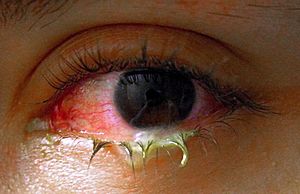Conjunctivitis facts for kids
Conjunctivitis, also known as pink eye, is when the clear covering over the white part of your eye and the inside of your eyelid gets swollen and red. It makes your eye look pink or reddish. You might feel pain, burning, scratchiness, or itchiness. Your eye might water a lot or be "stuck shut" in the morning. Sometimes, the white part of your eye can even swell up. If your eye is very itchy, it's often due to allergies. Pink eye can affect one eye or both.
The most common ways to get pink eye are from viruses or bacteria. A viral infection might happen when you have a common cold. Both viral and bacterial pink eye can easily spread from person to person. Allergies to things like pollen or animal hair are also common causes. Doctors usually figure out what it is by looking at your symptoms. Sometimes, they might take a small sample to test it.
You can help prevent pink eye by washing your hands often. How pink eye is treated depends on what caused it. For most viral cases, there's no special treatment, and it gets better on its own. Most bacterial cases also get better without treatment, but antibiotics can make you feel better faster. If you wear contact lenses and they caused your pink eye, you'll need treatment. Pink eye from allergies can be treated with special eye drops.
About 3 to 6 million people in the United States get pink eye each year. Adults usually get viral pink eye more often, while children tend to get bacterial pink eye. Most people feel better in one or two weeks. If you have blurry vision, a lot of pain, or your eyes are very sensitive to light, or if you don't get better after a week, you should see a doctor. Pink eye in a newborn baby, called neonatal conjunctivitis, also needs special care.
What are the Signs of Pink Eye?
When you have pink eye, your eye often looks red, the clear part of your eye might look swollen, and your eyes can be watery. However, the dark center of your eye (the pupil) should still react normally to light, and you should be able to see clearly.
Viral Pink Eye
Viral pink eye often happens when you have a common cold or a sore throat. Your eyes will usually be very watery and itchy. This type of pink eye often starts in one eye and can easily spread to the other.
Allergic Pink Eye
Allergic conjunctivitis is when your eye gets swollen and red because of an allergy. Different people can be allergic to different things.
Symptoms include redness (because tiny blood vessels get bigger), swelling of the clear part of the eye, itching, and lots of tears. If you also have a runny nose, it's called "allergic rhinoconjunctivitis." These symptoms happen because your body releases a substance called histamine. Histamine makes blood vessels bigger, irritates nerve endings, and makes your eyes produce more tears.
Bacterial Pink Eye
Bacterial pink eye makes your eye quickly turn red, your eyelids swell, and you'll have a thick, sticky discharge. Usually, symptoms start in one eye but can spread to the other within a few days. This type of pink eye often causes a gritty or scratchy feeling, like something is in your eye. You might have a grey or yellowish discharge that makes your eyelids stick together, especially after you sleep. The skin around your eye might also get crusty.
What Causes Pink Eye?
Pink eye caused by an infection is most often due to a virus. Bacterial infections, allergies, and other things that irritate your eye, like dryness, are also common causes. Both bacterial and viral infections are contagious and can spread from person to person. They can also spread through objects that have germs on them or even through water.
How is Pink Eye Diagnosed?
Doctors don't usually need to take samples for testing because most cases get better on their own or with common antibiotics. However, if your doctor thinks you have bacterial pink eye and it's not getting better with eye drops, they might take a sample to test for bacteria. If many people in an area get viral pink eye at the same time, they might test for the virus.
If your pink eye is caused by an allergy, a special patch test can help find out what you are allergic to.
How to Prevent Pink Eye
The best way to prevent pink eye is to keep your hands clean and avoid rubbing your eyes, especially if your hands aren't clean. Getting vaccinated against certain germs like adenovirus, haemophilus influenzae, pneumococcus, and neisseria meningitidis can also help.
A special eye solution called povidone-iodine has been found to prevent pink eye in newborn babies. Because it's not expensive, it's being used more often around the world for this purpose.
How is Pink Eye Treated?
Pink eye often gets better on its own in about two to five days, even without treatment. Most of the time, you don't need antibiotics.
Treating Viral Pink Eye
Viral pink eye usually goes away by itself and doesn't need any special treatment. Sometimes, medicines like antihistamines or mast cell stabilizers can be used to help with the symptoms, like itching.
Treating Allergic Pink Eye
For allergic pink eye, splashing cool water on your face with your head tilted down can help by making the tiny blood vessels smaller. Artificial tears can also make mild cases feel better. For more serious cases, doctors might prescribe special eye drops that reduce swelling or block histamine. If your allergic pink eye lasts a long time, you might need stronger steroid eye drops.
Treating Bacterial Pink Eye
Bacterial pink eye usually gets better without treatment. Eye drops with antibiotics might only be needed if you don't see any improvement after three days. While antibiotics can help you heal faster, serious problems are rare whether you use them or not.
Images for kids
See also
 In Spanish: Conjuntivitis para niños
In Spanish: Conjuntivitis para niños






